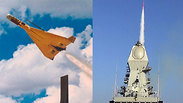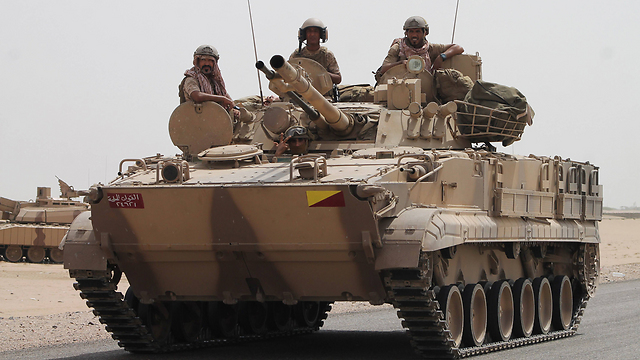
Suicide drone and Barak missile
Photo: IAF

Israel is 7th largest arms exporter in the world
Almost half of Israeli weapons exported over past 5 years to India, with other main buyers being Azerbaijan and Vietnam; in imports, Israel is 17th in the world, which increased its arms purchases by 125% over the past 5 years, buying 60% of its weapons from the US.
Israel exports weapons to countries across the world, with its biggest buyers being India,
Vietnam
and Azerbaijan,
according to a report released this week by the Stockholm International Peace Research Institute (SIPRI).
Israel is the 7th largest exporter of weapons in the world, according to the SIPRI report. Over the past five years, the export of Israeli weapons systems climbed by 55 percent compared to the five years that preceded it, which is the biggest increase among the top 10 arms exporters.
Almost half (49%) of Israeli weapons exported from 2013 to 2017 went to India, 13% to Azerbaijan and 6.3% to Vietnam.
Over the past year, Indian Prime Minister Narendra Modi visited Israel, while Prime Minister Benjamin Netanyahu recently made a reciprocal visit to India. During both visits, the two nations put an emphasis on massive sales of arms from Israel to India, including Barak aerial defense missiles, IAI Eitan (Heron TP) drones, airborne targeting and navigation pods, and several deals-in-the-making for IAI EL/M-2075 Phalcon, an early warning systems for aircraft, and Spike anti-tank missiles.
India tests Barak 8 missile (באדיבות משרד ההגנה ההודי)
Indian imports from Israel increased by 285% over the past five years, compared to 2008-2012, the report found.
According to the SIPRI report, Israel provided India and Azerbaijan with, inter alia, loitering munitions (known as a suicide drone).
There have been reports the Israeli IAI Harop drone, which is said to be a suicide drone, was seen in battles between Azerbaijan and Armenia. Video footage published by the Washington Post in 2016 purports to show an IAI Harop drone crashing onto targets in Armenia.
Video purporting to show Israeli suicide drone crashing on Armenian target
Israel's arms sale to Azerbaijan also led to a scandal. Israeli company Aeronautics reportedly carried out a "live demonstration" of an attack of one its suicide drones on a military post in Armenia at the request of Azerbaijan's military. The Israel Police's Lahav 433 unit, in conjunction with the Defense Ministry, launched an investigation against the company "about a deal with a significant client." A gag order has been placed on all details of the investigation and the names of the suspects.
Israel is also the third-largest arms provider for South Korea, Italy and Britain.
In arms imports, Israel is 17th in the world, according to the report. Israel has increased its import of arms by 125% over the past five years. Sixty percent of this weapon came from the United States, including 50 F-35 fighter jets, only nine of which has so far been delivered.
Germany was responsible for 30% of Israel's arms imports, including two submarines, but excluding three additional submarines that are at the center of a police corruption investigation.
Italy, which provides the Israeli Air Force with its training planes, is responsible for 10% of Israel's arms imports.
In total, there has been a 10% increase in international arms sales, with 32% of the weapons going to the Middle East. The arms import in the region has doubled over the past five years, continuing a similar trend in the five years that preceded it.
The United States, Britain and France are the largest arms suppliers to the Middle East, while Saudi Arabia, Egypt and the United Arab Emirates are the largest buyers. Britain, for example, sold almost half of its exported weapons to Saudi Arabia.
In total, Saudi Arabia has increased its arms imports by 225%, buying among other things 78 fighter jets, 72 combat helicopters and 328 tanks - used mostly in Riyadh's war against the Iran-backed Houthi rebels in Yemen.
Saudi is second largest arms importer after India, and is ahead of Egypt, UAE and China.
Meanwhile Iran, which has been fighting for years to keep the regime of Syrian President Bashar Assad in power, didn't even make it into the list of top 40 importers. According to the report, only 1% of the weapons coming into the region went to Tehran. The reasons for that, among other things, are the arms embargo on Iran and the fact it relies on its proxies (such as Hezbollah) and on terrorism to achieve its objectives. It is also possible covert arms deals were not included in the report.
The United States is the largest arms exporter in the world, selling weapons to at least 98 nations. Its weapons sale, which increased by 25%, made up one third of all international arms exports. Russia, number two on the list of exporters, saw a 7% drop in its arms sales. The American arms export from 2013 to 2017 was 58% bigger than Russian exports.
Almost half of the American arms over the past five years were sold to the Middle East, with Saudi Arabia at the top of its buyers list followed by the UAE, Australia, Taiwan, Iraq, India, Turkey, Britain and Egypt.
France, Germany, China and Britain complete the first 6 spots on the arms exporters list, followed by Israel at 7.


















